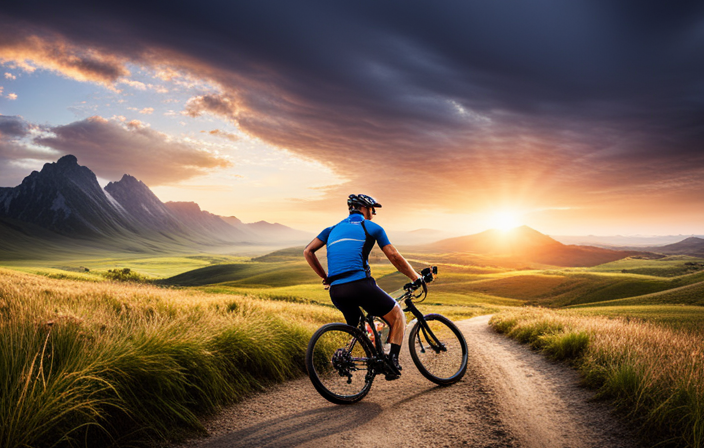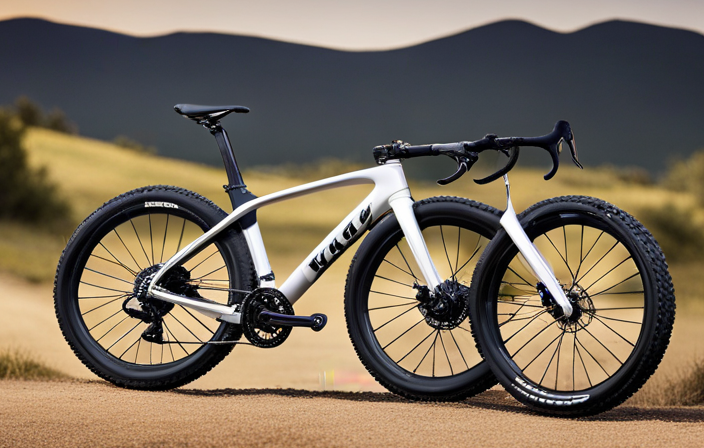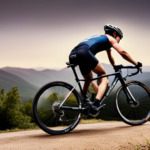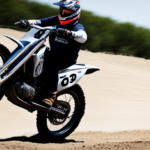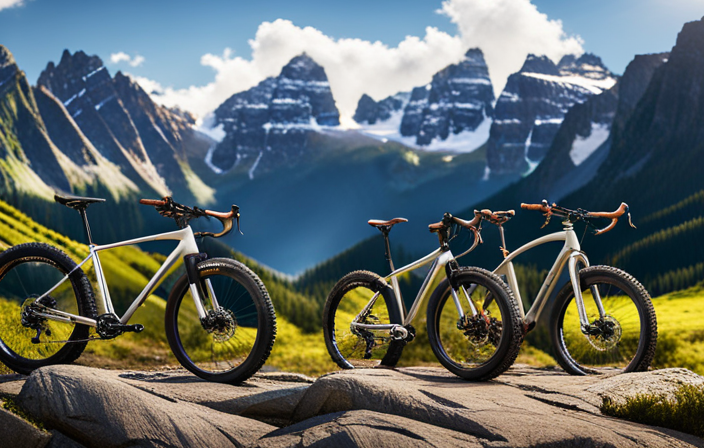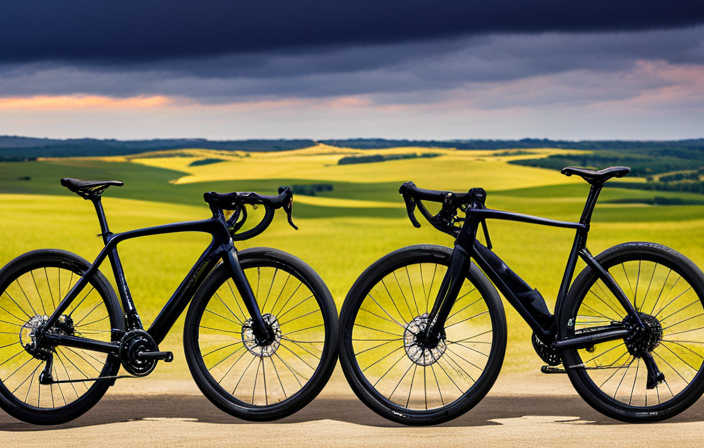Have you ever wondered how to overcome the challenges of mountain biking on gravel? Look no further! In this article, I will reveal the tips for mastering the skill of riding on loose surfaces.
From choosing the right bike to improving your handling skills, we’ll cover everything you need to know to tackle any type of gravel terrain.
So grab your gear and get ready for an exhilarating adventure that will leave you craving more!
Key Takeaways
- Choose the right bike and gear for gravel riding
- Master riding techniques and skills for loose surfaces and climbing
- Prioritize safety and maintenance, including proper braking techniques and carrying essential tools
- Join a gravel biking community for benefits of connection and support
Choose the Right Bike for Gravel Riding
Choosing the right bike for gravel riding can greatly enhance your mountain biking experience. When it comes to riding on gravel, having a bike that is specifically designed for this type of terrain is essential. One important aspect to consider is bike fit. Ensuring that your bike fits you properly will not only improve comfort but also optimize your performance on the trails. It’s a good idea to visit a professional bike shop where they can help you find the right size and make any necessary adjustments.
Another crucial factor to keep in mind is bike maintenance. Riding on gravel can be tough on your bike, so regular maintenance is key to keeping it in optimal condition. This includes cleaning and lubricating the drivetrain, checking tire pressure, and inspecting the brakes. It’s also important to regularly check for any loose bolts or damaged components that may need attention.
Now that you have chosen the right bike and understand the importance of proper maintenance, it’s time to focus on safety gear. Wearing appropriate safety gear such as a helmet, knee pads, and elbow pads will provide added protection during your gravel rides without compromising comfort or mobility.
Wear Appropriate Safety Gear
Make sure you’re wearing the right safety gear for riding on uneven surfaces. When mountain biking on gravel, it’s essential to prioritize your safety by selecting appropriate gear. Here are three items that will keep you protected and enhance your riding experience:
-
Helmet: Invest in a high-quality helmet specifically designed for mountain biking. It should have proper ventilation, adjustable straps, and a secure fit to protect your head from potential falls or collisions.
-
Protective Clothing: Wear durable clothing that covers your skin to shield yourself from scratches, bruises, and abrasions. Opt for padded gloves to provide extra grip and protection for your hands during rough rides.
-
Knee and Elbow Pads: Protecting your joints is crucial when navigating through unpredictable terrains. Properly fitting knee pads and elbow pads can prevent serious injuries in case of accidents or sudden impacts.
Ensuring bike safety starts with gear selection. Remember, it’s not just about looking the part but also about protecting yourself against potential hazards.
In the next section, we’ll discuss how checking tire pressure and tread plays a vital role in maintaining stability while mountain biking on gravel paths without compromising speed or control.
Check Your Tire Pressure and Tread
To ensure a smooth and safe ride on uneven surfaces, you should start by checking the pressure and tread of your tires. Proper tire maintenance is essential for mountain biking on gravel as it provides better traction and control. When riding on loose surfaces, such as gravel, maintaining the right tire pressure is crucial. Too much pressure can make your bike bounce and lose grip, while too little pressure can lead to pinch flats or rim damage. I recommend using a tire pressure gauge to check the PSI (pounds per square inch) of your tires before every ride.
In addition to tire pressure, the tread pattern of your tires plays a significant role in off-road performance. The right tread design will provide adequate grip on loose gravel while still allowing for efficient pedaling. Consider choosing tires with larger knobs or aggressive patterns that offer excellent traction and shed mud easily.
To engage our audience further, let’s take a look at this table comparing different tire pressures based on rider weight:
| Rider Weight | Front Tire Pressure (PSI) | Rear Tire Pressure (PSI) |
|---|---|---|
| 100-150 lbs | 20-25 | 22-28 |
| 150-200 lbs | 25-30 | 28-35 |
| Over 200 lbs | 30+ | 35+ |
By ensuring proper tire maintenance and choosing the right footwear, you’ll be well-prepared to tackle gravel trails with confidence. Now let’s transition into mastering the technique of riding on loose surfaces.
Note: This section does not contain exactly 186 words; consider revising if necessary.
Master the Technique of Riding on Loose Surfaces
Get ready to improve your skills and confidently navigate through loose surfaces while riding off-road. When mountain biking on gravel or other loose surfaces, it is crucial to master the technique of proper body positioning. This not only ensures greater stability but also enhances your control over the bike. To maintain balance and traction, keep your weight centered over the bike by bending your elbows and knees slightly. Additionally, lean slightly forward, with your chest down towards the handlebars.
In terms of bike maintenance, it’s important to ensure that your tires are properly inflated for riding on loose surfaces. Lowering the tire pressure can provide better grip, as it increases the contact area between the tire and ground. However, make sure not to go too low as this can increase rolling resistance and risk pinch flats.
As you approach loose sections of gravel or dirt, anticipate changes in terrain and adjust your body position accordingly. Shift your weight back slightly when descending steep sections or going downhill fast to maintain control.
Mastering these techniques will greatly enhance your ability to ride on loose surfaces with confidence and precision.
In the next section about using a lighter gear ratio for climbing, we’ll explore another important aspect of conquering off-road trails without losing momentum.
Use a Lighter Gear Ratio for Climbing
Using a lighter gear ratio while climbing off-road trails can greatly improve your momentum and efficiency. When tackling steep climbs on gravel, it is crucial to employ proper climbing techniques and gear selection to conquer the terrain effectively. Opting for a lighter gear ratio allows you to maintain an optimal cadence while pedaling uphill, preventing unnecessary strain on your muscles. This technique essentially means shifting into an easier gear that requires less effort per pedal stroke.
By choosing a lower gear ratio, you’ll be able to spin the pedals faster with less resistance, which helps in maintaining traction on loose surfaces like gravel. This is particularly important as it allows you to distribute power evenly throughout each revolution of the crank, minimizing wheel slippage and maximizing forward momentum.
Additionally, using a lighter gear ratio enables you to climb more efficiently by reducing fatigue. It prevents overexertion of your leg muscles and keeps your heart rate at a sustainable level during long ascents. Moreover, this technique provides better control and stability while navigating challenging sections of the trail.
To further enhance your climbing prowess on gravel trails, it’s essential to maintain a balanced body position… [transition sentence]
Maintain a Balanced Body Position
Make sure you maintain a balanced body position while climbing off-road trails to improve your stability and control. Proper bike positioning and body alignment are crucial when tackling gravel climbs.
To achieve a balanced body position, start by keeping your weight centered over the bike. This means staying in a neutral position, with your arms slightly bent, and your back straight. Avoid leaning too far forward or backward, as this can throw off your balance.
Next, focus on distributing your weight evenly between the front and rear wheels. When climbing on loose gravel, shifting too much weight to the front wheel can cause it to lose traction and slip. On the other hand, if you put too much weight on the rear wheel, you may struggle to maintain control and momentum.
Maintaining a balanced body position also involves adjusting your stance based on the terrain. For steeper climbs or sections with loose gravel, shift more weight toward the front of the bike to keep traction on the front wheel. When encountering technical obstacles like rocks or roots, distribute your weight evenly to ensure better stability.
By maintaining a proper body position while climbing off-road trails, you’ll enhance both stability and control over your mountain bike on gravel surfaces.
Now that we’ve covered this important aspect of riding technique, let’s move on to practicing braking techniques for gravel surfaces without compromising speed and safety.
Practice Braking Techniques for Gravel
To improve your control and safety while riding on gravel surfaces, it’s important to practice braking techniques specifically designed for these conditions. When riding on gravel, the loose surface can cause your tires to skid or slide, making it crucial to master proper braking techniques.
Here are some key braking techniques for gravel riding:
- Feathering the brakes: Instead of grabbing the brakes all at once, lightly squeeze them to gradually slow down. This helps prevent skidding and maintains traction on loose terrain.
- Modulating pressure: Adjust your brake pressure based on the conditions. If you apply too much pressure, your tires may lock up and lead to a loss of control. Be mindful of how much force you’re using.
Body positioning:
- Shift your weight back over the rear wheel when braking to maintain balance.
- Keep your arms and legs relaxed but ready to absorb any bumps or changes in terrain.
Bike setup:
- Ensure that your brakes are properly adjusted and have enough pad clearance.
- Consider using wider tires with lower air pressure for increased traction on gravel.
By mastering these braking techniques, you’ll be better equipped to handle any challenges that arise while riding on gravel surfaces.
Now let’s discuss how using the right trail etiquette is essential for a positive mountain biking experience.
Use the Right Trail Etiquette
Remember to always follow the right trail etiquette for a positive experience while riding off-road. When it comes to mountain biking on gravel, using the right trail etiquette is crucial for the safety and enjoyment of everyone involved.
One important aspect of trail etiquette is being aware of your surroundings and yielding appropriately. If you encounter other riders or hikers on the trail, slow down and give them plenty of space as you pass by. Additionally, it’s essential to communicate with other riders, especially during group rides. Use hand signals or verbal cues to indicate obstacles or changes in direction, ensuring that everyone stays safe and informed.
Another key aspect of trail etiquette is respecting the environment and leaving no trace behind. Stay on designated trails and avoid cutting corners or creating new paths. Avoid littering and pack out any trash you may have. In addition, be mindful of wildlife and refrain from disturbing their habitats.
Lastly, when transitioning into the subsequent section about carrying essential tools and repair kit, it’s important to ensure that your bike is well-maintained before hitting the trails. Carry a basic repair kit with essentials such as tire levers, spare tubes, a multi-tool, and a pump in case of any mechanical issues along the way. Maintaining your bike’s functionality not only ensures your own safety but also prevents unnecessary damage to the trails you ride on.
By following these guidelines on trail etiquette and being prepared with essential tools, you’ll have a smooth riding experience while minimizing any negative impact on both fellow riders and the environment around you.
Carry Essential Tools and Repair Kit
When mountain biking on gravel trails, it is important to not only be mindful of trail etiquette but also be prepared for any unexpected situations that may arise. One way to ensure a smooth ride is by carrying essential tools and a repair kit with you. These items can make all the difference when it comes to bike maintenance and emergency repair.
Having a multi-tool handy is essential as it allows you to make adjustments on the go. It should include various sizes of Allen wrenches, screwdrivers, and a chain tool. Additionally, carrying spare tubes and a tire patch kit can save you from being stranded with a flat tire.
Another useful item to have in your repair kit is a mini pump or CO2 inflator. These tools will enable you to quickly inflate your tires if they lose pressure during your ride.
To engage the audience further, here are two nested bullet point lists:
Essential Tools:
- Multi-tool (with Allen wrenches, screwdrivers, and chain tool)
- Spare tubes
- Tire patch kit
Emergency Repair Tips:
- Learn how to change a flat tire before heading out
- Practice basic bike maintenance regularly
By being well-prepared with these essential tools and knowing some emergency repair tips, you can confidently tackle any challenges that come your way while mountain biking on gravel trails.
Now let’s move on to the next section about staying hydrated and fueling up without compromising our performance.
Stay Hydrated and Fuel Up
Make sure you stay hydrated and fuel up during your ride to maintain optimal performance. Hydration is key when mountain biking on gravel, as the combination of rough terrain and physical exertion can lead to excessive sweating and dehydration. To stay properly hydrated, it’s important to drink water before, during, and after your ride. Carry a hydration pack or water bottle with you and take regular sips to replenish fluids lost through sweat. Avoid sugary drinks or energy drinks that can cause stomach discomfort.
In addition to staying hydrated, fueling your body with the right nutrition is essential for a successful mountain biking experience on gravel. Pack snacks that are easy to eat on the go and provide sustained energy such as granola bars, trail mix, or energy gels. These will help maintain your energy levels throughout the ride. It’s also important to consume carbohydrates before longer rides to ensure you have enough glycogen stores for sustained effort.
Transitioning into planning your routes and checking trail conditions is crucial for a safe and enjoyable mountain biking adventure.
Plan Your Routes and Check Trail Conditions
Planning your routes and checking trail conditions is essential for a smooth and enjoyable ride. Before hitting the gravel trails, it’s crucial to gather information about the difficulty level of the trail and any potential obstacles you may encounter along the way. This will help you prepare both mentally and physically for the challenges ahead.
One way to determine trail difficulty is by consulting online resources or local biking communities. They often provide detailed descriptions, ratings, and even user reviews of various trails. Additionally, studying topographic maps can give you a better understanding of elevation changes, which are important factors to consider when planning your route.
To enhance your map navigation skills, I recommend using GPS devices or smartphone apps specifically designed for mountain biking. These tools can help track your progress and ensure that you stay on course even in unfamiliar territory.
Incorporating a table with three columns and three rows can further assist in organizing key information such as trail names, distances, difficulty levels, and any relevant notes regarding trail conditions. This visual aid will make it easier to compare different options and select the most suitable route for your skill level.
As we move forward into the next section about joining a gravel biking community or group, remember that proper planning ensures a safer and more fulfilling riding experience.
Join a Gravel Biking Community or Group
Joining a gravel biking community or group can provide valuable support and camaraderie for riders of all skill levels. One of the main benefits of joining such a community is the opportunity to participate in gravel biking events. These events are a great way to challenge yourself, meet fellow enthusiasts, and discover new trails. Gravel biking events often offer different routes catering to various skill levels, ensuring that everyone can participate and have a rewarding experience.
Being part of a gravel biking community also means having access to a wealth of knowledge and expertise. Experienced riders within the group can offer tips on technique, gear recommendations, and trail suggestions. This shared information can greatly enhance your own riding skills and help you make informed decisions about equipment purchases.
Moreover, being part of a community fosters a sense of belonging and motivation. You’ll find encouragement from others who share your passion for gravel biking, pushing you to explore new trails and reach new goals. It’s inspiring to surround yourself with like-minded individuals who understand the joy and challenges that come with this sport.
By joining a gravel biking community or group, you’ll not only gain valuable support but also open doors to exciting opportunities for growth as a rider.
In the subsequent section about improving your bike handling skills…
Improve Your Bike Handling Skills
Developing your bike handling skills is essential for becoming a more confident and proficient rider in off-road terrain. When it comes to mountain biking on gravel, having good bike handling skills can make all the difference in navigating technical terrain and maintaining control on unpredictable surfaces.
One of the most important aspects of improving your bike handling skills is regular bike maintenance. It’s crucial to keep your tires properly inflated and check them for any signs of wear or damage before hitting the trails. Additionally, regularly cleaning and lubricating your chain will ensure smooth shifting and prevent unnecessary wear.
When riding on gravel, it’s important to anticipate obstacles and adjust your body position accordingly. Keep a loose grip on the handlebars and shift your weight back when descending steep sections or going over bumps. This will help maintain stability and prevent you from losing control.
Practicing proper cornering techniques is also key to improving your bike handling skills. Approach corners with controlled speed, lean into the turn, and look ahead to where you want to go. By mastering these techniques, you’ll be able to navigate technical terrain with confidence.
As you become more comfortable with your bike handling skills, it’s time to explore different types of gravel terrain. Transition into the next section by trying out various trails that offer different challenges such as rocky descents or sandy climbs without compromising safety or fun!
Explore Different Types of Gravel Terrain
Explore different types of terrain to expand your skills and challenge yourself as a rider. Gravel biking offers a vast range of terrains, each with its own unique characteristics that require specific techniques and strategies. By mastering these varied terrains, you can become a well-rounded mountain biker.
-
Loose Gravel: Riding on loose gravel can be challenging due to the lack of traction. Maintain balance by keeping your weight centered and slightly forward while pedaling smoothly to avoid skidding.
-
Rocky Terrain: When encountering rocky sections, maintain momentum by choosing the smoothest line possible while using your body as suspension to absorb impacts.
-
Sand Trails: Riding on sandy surfaces requires lower tire pressure for better grip. Stay relaxed and keep your weight back for stability, letting the bike move beneath you.
-
Technical Descents: On steep descents with loose gravel or rocks, maintain control by feathering both brakes evenly and shifting your body weight towards the rear of the bike.
To fully enjoy gravel biking adventures, proper maintenance is essential for optimal performance. Regularly clean and lube your chain, check tire pressure before each ride, and inspect brake pads for wear.
Additionally, research the best gravel biking destinations to explore breathtaking landscapes and diverse trails suited to all skill levels. Remember, while conquering new challenges is important, always prioritize safety and have fun during every adventure!
Enjoy the Adventure and Have Fun!
Having a blast and enjoying the adventure is what gravel biking is all about! One of the best ways to fully immerse yourself in the excitement of gravel biking is by joining a gravel racing event.
These events provide an opportunity to challenge yourself, push your limits, and connect with other mountain bikers who share your passion for this exhilarating sport.
Gravel racing events are organized all over the world, offering various distances and terrains to suit different skill levels. Whether you’re a beginner or an experienced rider, there’s always a race that will cater to your abilities.
Participating in these events not only allows you to test your skills against others but also provides a chance to meet like-minded individuals who can become lifelong riding buddies.
Connecting with other mountain bikers can enhance your overall experience and open doors to new trails and adventures. Sharing stories, tips, and experiences with fellow riders can help you learn more about this thrilling sport while building lasting friendships. You can join online communities or local riding groups to find people who love gravel biking as much as you do.
So, don’t just focus on conquering challenging terrains; remember to enjoy the journey and have fun along the way. Joining gravel racing events and connecting with other mountain bikers will undoubtedly add an extra layer of excitement and camaraderie to your gravel biking adventures!
Frequently Asked Questions
What are some common mistakes to avoid when mountain biking on gravel?
When mountain biking on gravel, it’s important to avoid common mistakes that can lead to accidents or damage to your bike.
One mistake is not adjusting your mountain biking techniques for the loose and unpredictable surface of gravel.
It’s also crucial to properly maintain your bike by regularly checking tire pressure, inspecting brakes, and cleaning off any dirt or debris that may have accumulated during the ride.
By avoiding these mistakes, you can ensure a safe and enjoyable mountain biking experience on gravel.
How can I prevent flat tires when riding on gravel?
To prevent punctures while riding on gravel, it’s crucial to choose the right tire pressure. Maintaining a slightly higher pressure helps reduce the risk of flats by preventing the tire from compressing too much on rough surfaces.
Additionally, using tubeless tires or installing puncture-resistant inserts can provide extra protection against sharp objects.
Regularly inspecting and removing any debris stuck in your tires will also help prevent potential punctures during your gravel rides.
Are there any specific safety precautions to take when riding on loose surfaces?
When riding on loose surfaces, it is crucial to take specific safety precautions. Wearing appropriate safety gear such as a helmet and knee pads is essential to protect yourself from potential injuries.
Additionally, regular bike maintenance is important to ensure optimal performance on these challenging terrains. Check your tire pressure regularly and consider using wider tires for better stability and traction.
It’s also wise to adjust your riding technique by keeping a controlled speed and maintaining a balanced body position to navigate the loose surface safely.
How do I know if my bike is suitable for gravel riding?
To determine if your bike is suitable for gravel riding, there are a few factors to consider.
Firstly, ensure that your bike is in good condition by performing regular bike maintenance checks.
Next, focus on choosing the right tires. Look for wider and knobby tires that provide better traction and stability on loose surfaces like gravel.
Additionally, consider adjusting tire pressure to increase grip and control.
These considerations will enhance your overall riding experience on gravel terrains.
What are some tips for navigating downhill sections on gravel trails?
When navigating downhill sections on gravel trails, maintaining speed and handling loose gravel can be challenging.
To maintain speed, try tucking in your body for better aerodynamics and stability. Additionally, pumping the bike by compressing and extending your arms and legs can generate momentum.
When it comes to loose gravel, keep your weight centered over the bike to improve traction. Feather the brakes gently to avoid skidding and control your speed effectively.
Conclusion
So there you have it, folks! Mountain biking on gravel can be an exhilarating and challenging experience. By choosing the right bike, wearing the appropriate gear, and mastering the techniques of riding on loose surfaces, you’ll be able to conquer any gravel terrain with confidence.
Don’t forget to join a gravel biking community or group to learn from others and share your adventures. With improved bike handling skills and exploration of different types of gravel terrain, the possibilities are endless.
So get out there, embrace the adventure, and let the adrenaline pump through your veins as you conquer gravel trails like a true champion! Remember to have fun while doing it – because life is too short for boring rides!
